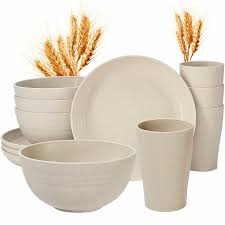 In today’s world, more people are paying attention to sustainability, especially when it comes to everyday products like tableware. Disposable plates made from eco-friendly materials such as wheat straw and bamboo have become increasingly popular alternatives to plastic and styrofoam. They offer a sustainable option for parties, picnics, catering events, and even home dining.
In today’s world, more people are paying attention to sustainability, especially when it comes to everyday products like tableware. Disposable plates made from eco-friendly materials such as wheat straw and bamboo have become increasingly popular alternatives to plastic and styrofoam. They offer a sustainable option for parties, picnics, catering events, and even home dining.
But when you’re faced with the choice between wheat straw plates and bamboo plates, how do you know which one is right for your needs? This guide will explore their differences, benefits, drawbacks, and best uses so you can make an informed decision.
What Are Wheat Straw Plates?
Wheat straw plates are made from the stalks left over after wheat grains are harvested. Instead of burning or discarding these stalks, manufacturers repurpose them into sturdy and biodegradable tableware.
Key Features of Wheat Straw Plates:
Eco-friendly: They are compostable and break down naturally without releasing harmful toxins.
Durable: Stronger than many expect—resistant to breaking and cracking.
Lightweight: Easy to carry, making them ideal for outdoor events.
Affordable: Often less expensive than bamboo alternatives.
Best Uses:
Wheat straw plates are great for casual gatherings, everyday family use, or large-scale events where cost-effectiveness and sustainability are equally important.
What Are Bamboo Plates?
Bamboo plates are crafted from natural bamboo fibers. Bamboo is a fast-growing, renewable resource, making it one of the most sustainable materials for eco-friendly tableware.
Key Features of Bamboo Plates:
Durable & Sturdy: Bamboo plates tend to feel stronger and more rigid than wheat straw options.
Premium Look: Their texture and design often look more polished, which is great for formal events.
Heat Resistance: They can handle both hot and cold foods without warping.
Compostable: Like wheat straw, they decompose naturally.
Best Uses:
Bamboo plates are excellent for weddings, upscale parties, or corporate events where presentation matters as much as sustainability.
Wheat Straw vs Bamboo Plates: The Key Differences
If you’re still wondering which to choose, here’s a side-by-side comparison:
| Feature | Wheat Straw Plates | Bamboo Plates |
| Material | Byproduct of wheat stalks | Bamboo fiber |
| Durability | Sturdy but lighter | Stronger and more rigid |
| Appearance | Simple, often matte | Sleek, polished finish |
| Price | More budget-friendly | Slightly higher cost |
| Eco-Friendliness | 100% compostable | 100% compostable |
| Best For | Picnics, casual events | Weddings, formal dining |
👉 For a more detailed comparison, you can check out Wheat Straw vs Bamboo Plates at AnzhuCraft, where both materials are explained in depth.
Environmental Benefits of Using Eco-Friendly Plates
Switching to wheat straw or bamboo plates helps reduce plastic waste and supports sustainable practices. Here are some key benefits:
Reduces Plastic Pollution – Both options biodegrade naturally, unlike plastic plates that take hundreds of years to decompose.
Minimizes Carbon Footprint – Wheat straw utilizes agricultural waste, while bamboo grows quickly without the need for pesticides.
Supports Circular Economy – By choosing compostable plates, you contribute to a waste-to-resource cycle.
Safe for Health – Free from harmful chemicals like BPA and toxins found in plastics.
Cost Considerations: Which Is More Budget-Friendly?
One of the main deciding factors for many people is cost.
Wheat Straw Plates: Usually more affordable since they are made from agricultural byproducts. Ideal for large gatherings where budget is key.
Bamboo Plates: Tend to be more expensive due to the manufacturing process and the premium look they offer. Better suited for smaller, high-end events.
If you’re organizing a large party and want to keep costs down while staying eco-friendly, wheat straw is a great option. But if you’re hosting a wedding reception or business dinner, bamboo may be worth the extra investment.
Durability and Performance
Both wheat straw and bamboo plates are strong, but bamboo has the edge when it comes to handling heavier or greasy foods. Bamboo plates are less likely to bend or leak, making them reliable for buffet-style events.
Wheat straw plates are durable enough for most meals, but they are best used for lighter dishes, salads, or dry snacks.
Health and Safety Factors
Both materials are safe to use and free of harmful plastics. However, always ensure you buy from reputable sources like AnzhuCraft, which specializes in high-quality, eco-friendly disposable tableware.
Low-quality alternatives may contain chemical additives, so sticking with trusted suppliers is crucial.
Which One Should You Choose?
Your choice depends on your priorities:
Go with wheat straw plates if:
You’re hosting a casual, large-scale event.
You want a cost-effective eco-friendly option.
Lightweight and disposable plates meet your needs.
Go with bamboo plates if:
You’re organizing a formal or professional event.
You prefer a stronger, premium look and feel.
Presentation and durability are your top priorities.
Final Thoughts
Both wheat straw and bamboo plates are excellent eco-friendly alternatives to plastic. They reduce environmental impact, are safe for health, and provide a convenient way to enjoy disposable tableware without guilt.
If budget and convenience are important, wheat straw plates are the better choice. But if you want something elegant and durable, bamboo plates are the way to go.
For more insights and options, check out Wheat straw vs bamboo plates at AnzhuCraft, a trusted source for eco-friendly disposable tableware.